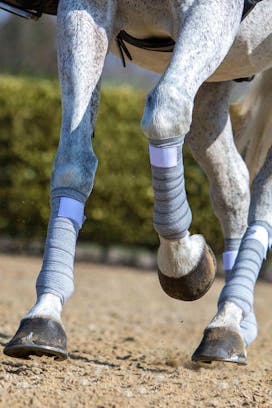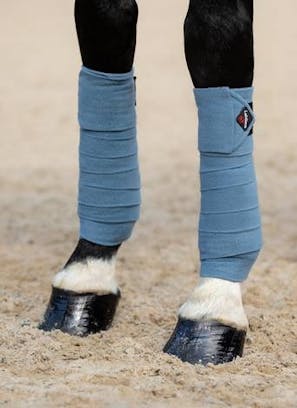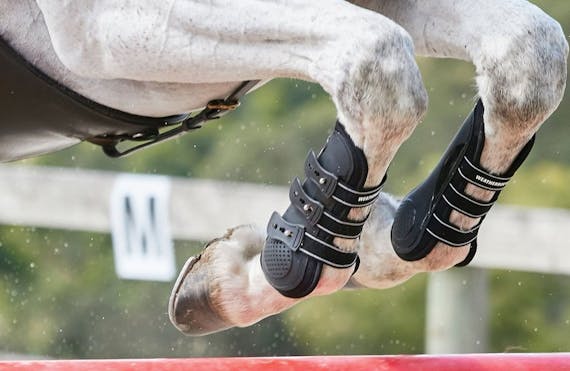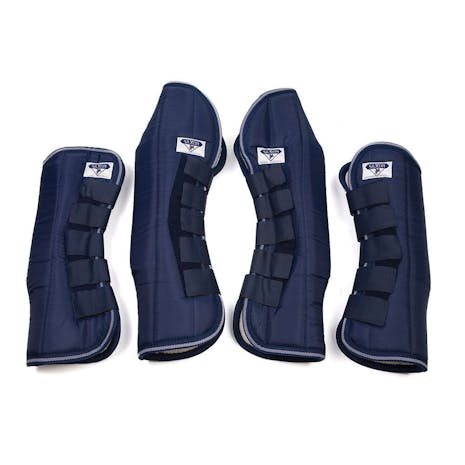What are leg wraps?
Horse leg wraps are pieces of equipment used to provide support and protection to a horse's legs during exercise, training, or transport. Leg wraps can help to prevent injuries and reduce swelling or inflammation, as well as provide additional support to the tendons and ligaments in the horse's legs.
Here are some additional details about horse leg wraps:
Leg wraps come in different types and sizes, depending on the specific needs of the horse. Some common types of leg wraps include polo wraps, standing wraps, and shipping boots. Each type of wrap serves a different purpose and is designed to be used in specific situations.
Polo wraps are long, thin bandages that are wrapped around the horse's leg from the fetlock to the knee. They are often used during exercise to provide support to the tendons and ligaments in the horse's legs, as well as to help prevent injuries from impact or overuse.
Standing wraps are similar to polo wraps but are typically thicker and more supportive. They are often used to provide additional support and protection to the horse's legs while they are standing or resting, such as in the stable or during transport.
Shipping boots are designed to protect the horse's legs during transportation. They are typically made of thicker, more durable materials than polo wraps or standing wraps, and provide additional padding and protection to the horse's legs while they are in transit.
It is important to use leg wraps properly and to monitor the horse for any signs of discomfort or irritation. Improperly applied leg wraps can cause discomfort or even injury to the horse's legs, so it is important to follow proper technique and to ensure that the wraps are not too tight or too loose.


Leg Wrap Info...

Leg Boots...
What are leg boots?
Horse leg boots are commonly used to provide protection and support to a horse's legs during various activities, such as riding, jumping, or participating in equestrian sports. Here are some key points about horse leg boots for protection:
What are the Types of Leg Boots?
There are several types of leg boots available for different purposes. Some common types include:
1. Splint Boots: These boots are designed to protect the splint bones on the inside of the horse's leg. They provide impact resistance and help prevent injuries caused by knocks or strikes.
2. Fetlock Boots: Fetlock boots are designed to protect the back of the horse's fetlock joint. They provide support and help prevent overextension or hyperflexion of the joint during activities that involve quick turns or jumps.
3. Open-Front Boots: These boots are designed to protect the front of the horse's leg while leaving the front of the fetlock joint exposed. They offer protection against impact while allowing more freedom of movement for the horse.
4. Cross-Country Boots: Cross-country boots are designed specifically for eventing or cross-country jumping. They provide a higher level of protection and coverage, extending from the cannon bone to the fetlock and often include additional features like strike plates for added impact resistance.
How do they protect and support?
Leg boots offer protection against potential injuries, such as knocks, scrapes, or strikes that can occur during training, competitions, or trail riding. They can help minimize the risk of bruising, lacerations, or tendon damage caused by contact with obstacles or the horse's own legs.
Joint Support: Some leg boots, such as fetlock boots, provide additional support to the joints, helping to reduce strain and minimize the risk of hyperextension or other injuries during strenuous activities.
Proper Fit and Application: It is essential to ensure that leg boots fit properly and are applied correctly to maximize their effectiveness. Poorly fitting or incorrectly applied boots can cause discomfort, restrict movement, or even lead to other issues. Consulting with a knowledgeable equestrian professional or veterinarian can help ensure the appropriate selection and fitting of leg boots for your horse.
Remember that leg boots should not be a substitute for proper training, conditioning, and regular veterinary care. They are a supplemental tool designed to offer an extra layer of protection and support for your horse's legs during specific activities


travelling boots...
what is the Purpose for travelling boots?
Traveling boots, also known as transport boots or shipping boots, are protective gear designed to safeguard a horse's legs during transportation. Here is some information about horses traveling boots:
The primary purpose of traveling boots is to provide protection to a horse's legs during transportation. They help minimise the risk of injuries caused by accidental strikes or bumps that may occur when a horse is confined in a trailer or during loading and unloading.
whats the Design and Construction?
Traveling boots typically cover the horse's lower limbs, including the cannon bone, fetlock, and sometimes the hock. They are made of durable and padded materials, such as neoprene or synthetic fabrics, to provide cushioning and impact absorption. The boots often have Velcro or buckle closures for secure fastening and adjustable straps to ensure a snug fit.
Types of Traveling Boots: There are various types of traveling boots available, including:
Open Front Boots:
These boots have an open front to allow freedom of movement for the horse's knees while providing protection to the cannon bone and fetlock.
- Full Coverage Boots:
Full coverage boots encase the entire lower limb, including the cannon bone, fetlock, and sometimes the hock, providing maximum protection during transportation.
- Shipping Wraps:
Shipping wraps are long, padded bandages that are wound around the horse's legs and secured with Velcro. They offer protection similar to boots but may require more skill to properly apply.
the Proper Use and Fit for these...
It is important to use traveling boots that fit the horse correctly and are properly secured. Ill-fitting or loose boots may slip during transport and potentially cause more harm than good. Always follow the manufacturer's instructions for fitting and using the boots correctly.
what are the Supplementary Safety Measures?
While traveling boots provide leg protection, they should not be solely relied upon for safety during transportation. Other precautions, such as ensuring a well-maintained trailer, providing adequate bedding, and practicing safe loading and unloading procedures, should also be observed to ensure the horse's well-being.
Click here to shop the latest leg wraps for your furry bestfriend!
Shop down below!

click here to shop the latest travel boots for your best friend!




